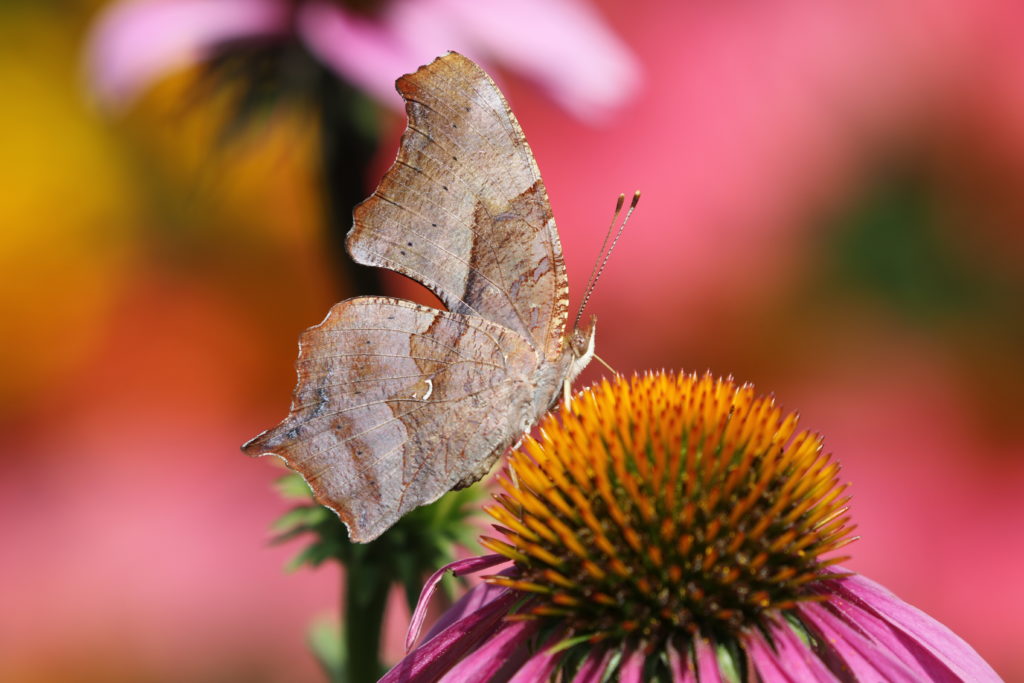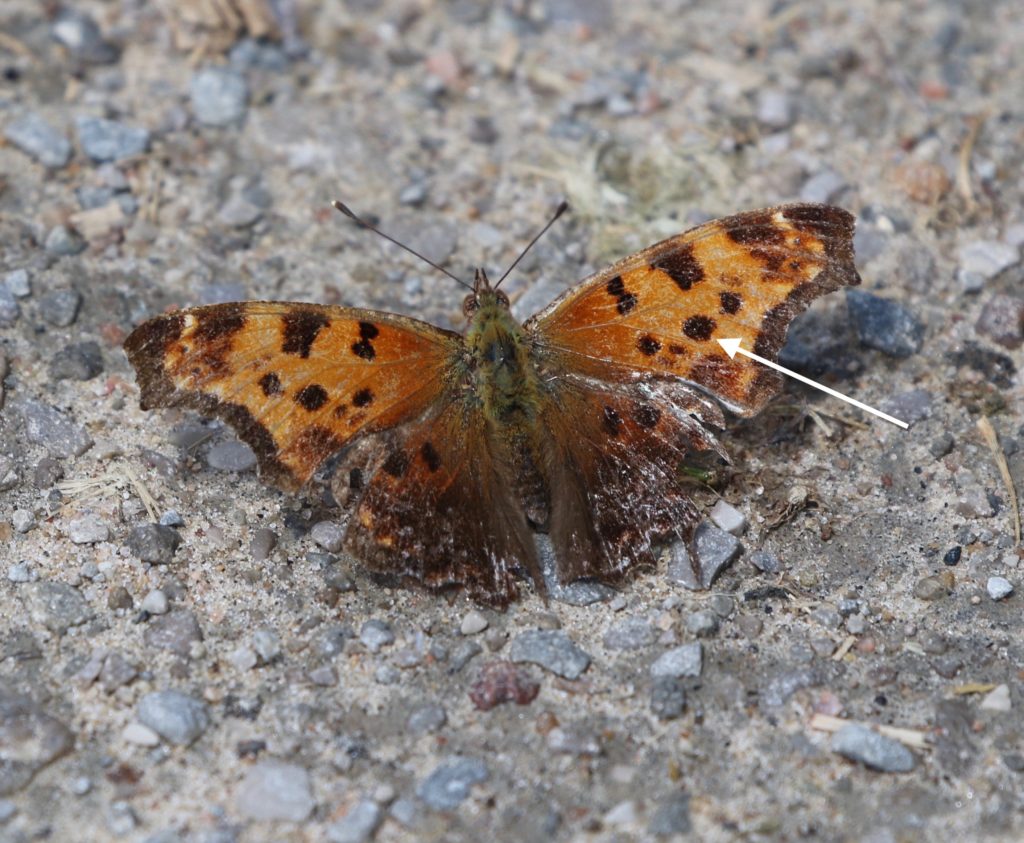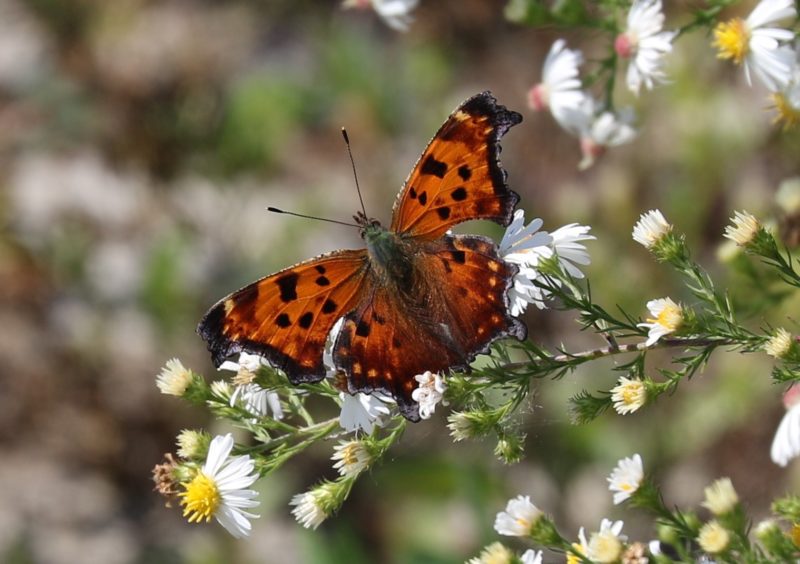My problem with Commas is one of disappointment. Three species of Comma—the Eastern, the Gray, and the Green—appear in Southern Ontario; but in Toronto, where I do most of my butterflying, I’ve only ever seen the Eastern. Each time I find another Comma, I hope it’s something different. But when I come home and examine the photos on my desktop, I’m invariably disappointed: just another Eastern. This has been happening for years.
So when I drove up to the Carden Alvar on July 31st to look for types of butterflies I don’t usually see in Toronto, a different species of Comma was at the top of my list.
Commas are medium-sized and very beautiful butterflies. They belong to a group called the Anglewings because the outline of their wings forms several acute angles instead of the simple curve seen in the wings of Fritillaries or Sulphurs, Whites or Hairstreaks.
As you can see in the feature photo to this post, the upperside of their wings is deep orange, with a pattern of dark and light spots. The underside is more cryptically colored in shades of gray and brown, which gives these butterflies the appearance of a dead tree leaf when they close their wings above the abdomen.

Commas take their name from the silver sliver that appears on their underwing, and that in its curved shape resembles the punctuation mark. Scientifically, they fall within the genus Polygonia. This genus includes a species called the Question Mark (Polygonia interrogationis), whose silver underwing squiggle looks something like—if you really squint—an interrogation point. Sadly for the grammarians among us, there are no Polygonia species named after semi-colons or exclamation points.

At the Carden Alvar, I spent my first two hours observing the Fritillaries that were nectaring on wildflowers. Generally speaking, Commas aren’t so passionate about flowers as a source of nourishment. They much prefer to drink tree sap leaking from Sapsucker holes or feeding on dung or dead animals. They also like to sit on dirt roads, where they sip up moisture and salts while slowly opening and closing their wings.
So I didn’t see any Commas until late in the day, when I started walking Wylie Road, the dirt track that forms the park’s western boundary. North of the Sedge Wren Marsh and outside the gate to Windmill Ranch, I found several butterflies mudpuddling in the middle of the road. One turned out to be a Comma.

There was something about the shape of its wings—the indentations along the outer edge seemed sharper, more jagged, than in an Eastern—that made me think I’d finally found a Gray or a Green Comma. But when I took a moment to look at the photos on my camera’s playback feature, which allows me to blow up each photo and examine it in detail, that familiar feeling of disappointment overwhelmed me: just another Eastern, the species that’s a dime a dozen in Toronto.

By this time, it was getting late. I turned and started walking back to the car, which I’d parked south of the Sedge Wren Marsh. After I’d crossed a small footbridge and was drawing near the parking place, I saw another Comma sitting with its wings open in the middle of the road. I started snapping pictures and edging closer. The butterfly seemed oblivious until I was almost on top of it, when it flew off to a bush on the edge of the marsh.
It held there with wings closed, which allowed me to photograph the underside with the silver comma on the hindwing. This field mark, the comma, is shaped slightly differently in each species, so it can be a useful clue to the butterfly’s identity.

Back at the car, I sat in the shade to examine the photos. On the underside, the silver comma was shaped in a way I’d never seen before: it formed a narrow V and was tapered at each end to a thin point. (On the Eastern Comma, both ends of the comma are club shaped.) Then I looked at the upperside to confirm and could see that, among other things, the black dots there were smaller than on the Eastern Comma I’d observed earlier. There couldn’t be any doubt. I finally had it; I’d finally found my first Gray Comma. The Green will have to wait for another day.


Wonderful to see someone so patient and focused on detail in order to appreciate fully these lovely and complex creatures! This piece will encourage me to pay more attention when I see a butterfly! Thank you for the lesson, Ed!
Thanks, Jeannette–glad you enjoyed it. And glad to hear that you’re getting interested in butterflies!
Nice post, Ed. Instructive and beautifully illustrated.
Thanks, Barry–the butterflies have got me hooked.